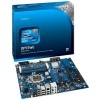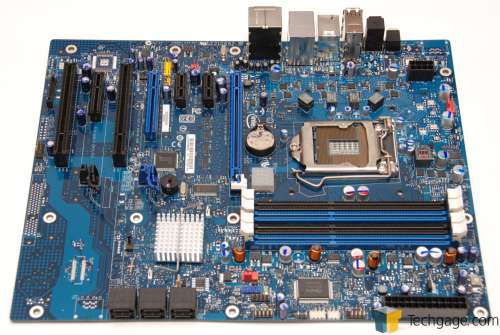- Qualcomm Launches Snapdragon 4 Gen 2 Mobile Platform
- AMD Launches Ryzen PRO 7000 Series Mobile & Desktop Platform
- Intel Launches Sleek Single-Slot Arc Pro A60 Workstation Graphics Card
- NVIDIA Announces Latest Ada Lovelace Additions: GeForce RTX 4060 Ti & RTX 4060
- Maxon Redshift With AMD Radeon GPU Rendering Support Now Available
Intel DP55WG

For most consumers, Intel might not be the first name to come to mind when building a new PC, but the company offers a rather robust line-up of boards for each chipset it releases. We’re looking at the $140 “mainstream” DP55WG, which has an simple overall feature-set, but includes support for IR and also NVIDIA’s SLI.
Page 9 – Power Consumption, Final Thoughts
It goes without saying that power efficiency is at the forefront of many consumers’ minds today, and for good reason. Whether you are trying to save money or the environment – or both – it’s good to know just how much effort certain vendors are putting into their products to help them excel in this area. Both AMD and Intel have worked hard to develop efficient chips, and that’s evident with each new launch. The CPUs are getting faster, and use less power, and hopefully things will stay that way.
To help see what kind of wattage a given processor draws on average, we use a Kill-A-Watt that’s plugged into a power bar that’s in turn plugged into one of the wall sockets, with the test system plugged directly into that. The monitor and other components are plugged into the other socket and is not connected to the Kill-A-Watt. For our system specifications, please refer to our methodology page.
To test, the computer is first boot up and left to sit at idle for five minutes, at which point the current wattage is recorded if stable. To test for full CPU load, LinX is run with 2560MB memory usage for a total of five minutes. During that run, the highest point the wattage reaches on the meter is captured and becomes our “Max Load”.

Compared to Intel’s competition here, the DP55WG looks like a bag of Lays regular chips next to a bag of Doritos… one has a much bigger punch than the other. So it’s no surprise that it proved to have the best power consumption, hitting a max load of 38W less than the P55A-UD4P from Gigabyte.
Final Thoughts
One word I’ve caught myself using over and over during this review is “simple”, and when I think about it, I’m not sure what better word there is to use. It’s not that the board is completely lackluster, but compared to most other boards we look at on a regular basis, it is simple. The board, as bare as it may be, still manages to look good, and it’s easy to appreciate it when you ponder the fact that Intel favors stability over all else. It’s nice to have that kind of confidence in a board you just purchased.
Simply put, the DP55WG is a good board. It’s built well, has a smart design, and takes a no-nonsense approach to things, and that much I can appreciate. But a major problem is that this board doesn’t cost $100, but rather $140. For $140, there are better choices out there. They might not share Intel’s passion for stability or reliability (though at stock speeds, all motherboards should be reliable), but it’s hard to even look at the DP55WG when other more interesting options exist.
Gigabyte’s P55A-UD3 is a good example of this. It costs $140, like the DP55WG, but offers more, and not just in bling. First, it includes good heatinks in all key areas, and an improved power phase setup for real overclocking opportunity. In addition, it has additional S-ATA ports, more USB ports at the back, and generally improved connectivity in general. It even supports S-ATA 3.0 (6Gbit/s) and USB 3.0… two technologies that are nice to have now, even if they aren’t “mainstream” quite yet.
I point out the P55A-UD3 primarily because it looks to be the “best” board for exactly $140. If you’re willing to spend just a bit more for something even more feature-rich, all it takes is another $10 or $20, and the options are at least fivefold. When looking at options such as those, it doesn’t make much sense that Intel’s is $140. What redeems the board is the addition of the IR receiver for media PC use, and also the ability to take advantage of NVIDIA SLI, but at $140, there are better options out there, unless those two things in particular mean an awful lot to you.
Discuss this article in our forums!
Have a comment you wish to make on this article? Recommendations? Criticism? Feel free to head over to our related thread and put your words to our virtual paper There is no requirement to register in order to respond to these threads, but it sure doesn’t hurt!
Support our efforts! With ad revenue at an all-time low for written websites, we're relying more than ever on reader support to help us continue putting so much effort into this type of content. You can support us by becoming a Patron, or by using our Amazon shopping affiliate links listed through our articles. Thanks for your support!






